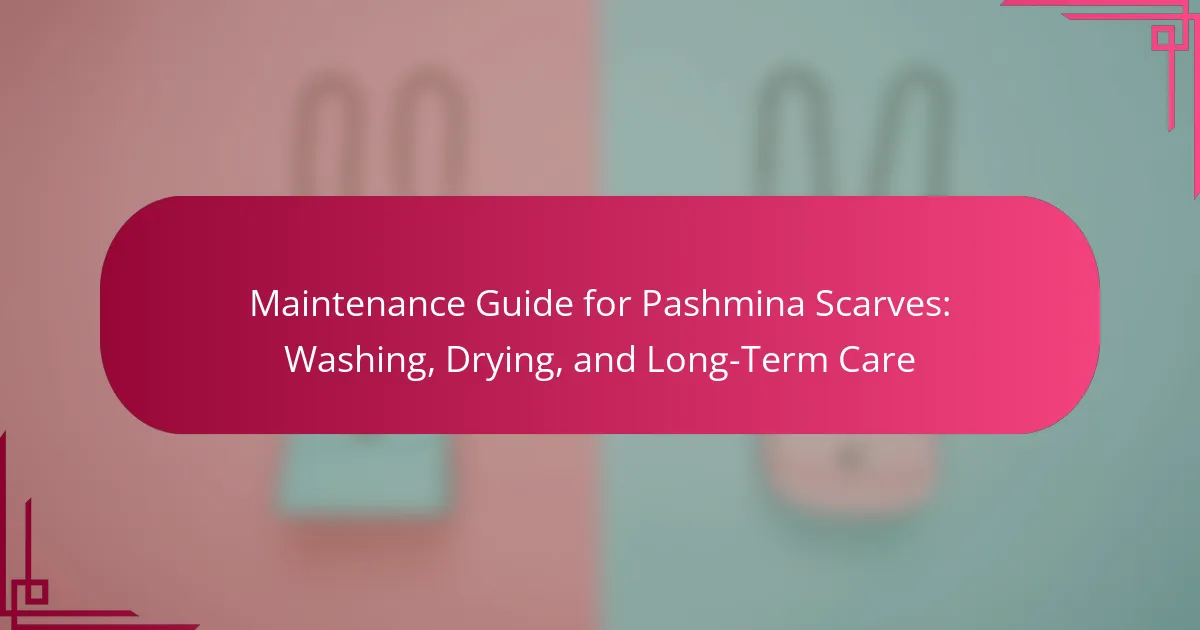Pashmina scarves are fine cashmere accessories made from the wool of Pashmina goats, primarily located in the Himalayan regions of Nepal, India, and Tibet. Known for their exceptional softness, warmth, and lightweight properties, Pashmina scarves are often handwoven, showcasing unique craftsmanship. This guide provides essential information on washing, drying, and long-term care techniques to maintain the quality and integrity of Pashmina scarves. Key maintenance practices include gentle hand washing in cold water, proper drying methods to prevent damage, and appropriate storage techniques to protect against wear and pests. Following these guidelines will help ensure the longevity and luxurious feel of your Pashmina scarf.

What is a Pashmina Scarf?
A Pashmina scarf is a type of fine cashmere scarf made from the wool of Pashmina goats. These goats are primarily found in the Himalayan regions of Nepal, India, and Tibet. Pashmina wool is known for its softness, warmth, and lightweight characteristics. The fibers used in Pashmina scarves are exceptionally fine, measuring around 12-15 microns in diameter. This results in a luxurious texture that is gentle against the skin. Pashmina scarves are often handwoven, which adds to their uniqueness and craftsmanship. The term “Pashmina” translates to “soft gold” in Persian, reflecting its high value and quality.
How is a Pashmina Scarf different from other types of scarves?
A Pashmina scarf is different from other types of scarves due to its unique material and craftsmanship. Pashmina is made from the fine undercoat of the Changthangi goat, found in the Himalayas. This material is exceptionally soft and warm, unlike standard wool or synthetic fabrics. A Pashmina scarf typically has a luxurious feel and drapes beautifully.
The production process of Pashmina involves hand-spinning and weaving, which adds to its exclusivity. In contrast, many other scarves are mass-produced using machines. Pashmina scarves are also known for their intricate designs and patterns, often featuring traditional motifs. This level of detail is less common in other scarf types.
Additionally, Pashmina scarves require special care to maintain their quality. They should be dry cleaned or hand washed in cold water, unlike many other scarves that can be machine washed. These differences highlight the distinct nature of Pashmina scarves compared to other types.
What materials are used to make Pashmina Scarves?
Pashmina scarves are primarily made from the fine wool of the Changthangi goat. This goat is native to the Himalayan region. The wool is known for its softness and warmth. Pashmina fibers are extremely fine, measuring about 12-14 microns in diameter. The production process involves hand-harvesting the wool during the molting season. After harvesting, the fibers are cleaned and spun into yarn. This yarn is then woven into scarves using traditional techniques. The unique properties of Pashmina wool make these scarves highly sought after for their luxurious feel and insulation.
What qualities define a high-quality Pashmina Scarf?
A high-quality Pashmina scarf is defined by its softness, warmth, and durability. Softness is primarily due to the fine cashmere fibers used in its production. These fibers are sourced from the undercoat of Himalayan goats. Warmth is another key quality, as Pashmina provides excellent insulation while remaining lightweight. Durability is ensured through proper weaving techniques, which enhance the scarf’s lifespan.
Additionally, a high-quality Pashmina scarf typically features a smooth texture and a natural sheen. The color and dye quality also reflect its quality; natural dyes are preferred for their depth and richness. Lastly, a well-crafted Pashmina scarf will have neatly finished edges, often with hand-rolled hems. These characteristics collectively ensure that the scarf is not only luxurious but also functional and long-lasting.
Why is proper maintenance important for Pashmina Scarves?
Proper maintenance is crucial for Pashmina scarves to preserve their quality and longevity. These luxurious scarves are made from delicate fibers that can easily be damaged. Regular cleaning prevents dirt and oils from accumulating, which can degrade the fabric. Additionally, proper storage helps maintain their shape and prevents moth damage. Using gentle washing methods, such as hand washing or dry cleaning, protects the fibers from wear. Avoiding harsh chemicals ensures the colors remain vibrant. Following these maintenance practices can extend the lifespan of Pashmina scarves significantly.
What can happen if Pashmina Scarves are not cared for properly?
If Pashmina scarves are not cared for properly, they can suffer significant damage. Improper washing can lead to shrinking, altering the size and fit. Exposure to moisture without proper drying may cause mildew or mold growth. Incorrect storage can result in creases or permanent wrinkles. Additionally, neglecting to protect them from pests can lead to moth damage. These factors can diminish the scarf’s appearance and longevity. Proper care is essential to maintain the quality and beauty of Pashmina scarves.
How does maintenance affect the longevity of a Pashmina Scarf?
Proper maintenance significantly enhances the longevity of a Pashmina scarf. Regular cleaning prevents dirt and oils from breaking down the fibers. Hand washing with mild detergent is recommended to avoid damage. Air drying preserves the scarf’s shape and texture. Avoiding direct sunlight prevents fading and degradation. Storing the scarf in a cool, dry place prevents moth damage. These practices can extend the lifespan of a Pashmina scarf for many years. Regular maintenance ensures the scarf remains soft and retains its luxurious appearance.

How should I wash my Pashmina Scarf?
To wash your Pashmina scarf, hand wash it in cold water with a gentle detergent. Avoid using hot water as it can damage the fibers. Soak the scarf for about 5 to 10 minutes. Gently agitate the water to clean the fabric without wringing or twisting. Rinse thoroughly in cold water until all detergent is removed. Lay the scarf flat on a clean towel to absorb excess water. Avoid hanging it to dry, as this can cause stretching. Instead, reshape it and let it air dry away from direct sunlight. Following these steps helps maintain the scarf’s softness and integrity.
What are the recommended washing methods for Pashmina Scarves?
The recommended washing methods for Pashmina scarves include hand washing and dry cleaning. Hand washing is preferred to maintain the fabric’s quality. Use cold water and a mild detergent specifically designed for delicate fabrics. Gently agitate the scarf in the water without wringing or twisting it. Rinse thoroughly in cold water to remove all detergent. For dry cleaning, choose a reputable cleaner experienced with Pashmina. This method is safer for intricate designs and colors. Avoid machine washing or tumble drying, as these can damage the fibers. These practices help preserve the softness and durability of Pashmina scarves.
Should I hand wash or machine wash my Pashmina Scarf?
You should hand wash your Pashmina scarf. Hand washing is gentler and helps maintain the scarf’s softness and integrity. Machine washing can cause damage and lead to pilling or shrinking. The delicate fibers of Pashmina require careful handling. Using cold water and mild detergent is recommended for hand washing. This method preserves the color and texture of the scarf. Always lay the scarf flat to dry after washing. Following these guidelines ensures the longevity of your Pashmina scarf.
What detergents are safe for washing Pashmina Scarves?
Gentle, pH-neutral detergents are safe for washing Pashmina scarves. Look for products specifically labeled for delicate fabrics or wool. Brands like Eucalan and The Laundress offer suitable options. Avoid harsh chemicals and bleach, as they can damage the fibers. Always follow the manufacturer’s care instructions for best results.
How do I deal with stains on my Pashmina Scarf?
To deal with stains on your Pashmina scarf, act quickly. Blot the stain gently with a clean, dry cloth. Avoid rubbing, as this can spread the stain. Use cold water to rinse the affected area. For stubborn stains, mix a mild detergent with cold water. Apply this solution to the stain using a soft cloth. Rinse thoroughly with cold water afterward. Allow the scarf to air dry flat. According to fabric care experts, immediate attention to stains helps prevent permanent damage.
What steps should I take to treat specific types of stains?
To treat specific types of stains on pashmina scarves, identify the stain type first. For oil-based stains, blot the area with a paper towel. Apply a small amount of dish soap mixed with water. Gently dab the stain with a clean cloth. Rinse with cold water and let it air dry. For water-based stains like coffee or tea, immediately blot the stain with a clean cloth. Mix equal parts of white vinegar and water. Dab the mixture on the stain using a cloth. Rinse with cold water and air dry. For ink stains, place a paper towel under the fabric. Apply rubbing alcohol on a cotton ball and dab the stain. Blot until the ink lifts. Rinse with cold water and air dry. Each method effectively addresses common stains, ensuring the pashmina scarf remains in good condition.
Are there any products I should avoid when treating stains?
Avoid using bleach and harsh chemicals when treating stains on pashmina scarves. These products can damage the delicate fibers. Additionally, avoid using fabric softeners, as they may leave residues that affect the fabric’s texture. It is also advisable to steer clear of hot water, which can cause shrinkage. Using abrasive scrubbing tools can ruin the scarf’s surface. Always test any cleaning product on a small, inconspicuous area first. This precaution helps ensure that the product won’t harm the fabric.

What are the best drying techniques for Pashmina Scarves?
The best drying techniques for Pashmina scarves include air drying and laying flat on a clean towel. Air drying helps maintain the scarf’s shape and texture. It is essential to avoid direct sunlight to prevent fading. Laying the scarf flat on a towel absorbs excess moisture while preventing stretching. Avoid wringing or twisting the fabric, as this can distort its shape. Additionally, using a mesh drying rack can promote airflow and further protect the scarf. These methods ensure the longevity and quality of the Pashmina material.
How should I dry my Pashmina Scarf after washing?
To dry your Pashmina scarf after washing, gently lay it flat on a clean, dry towel. Avoid wringing or twisting the scarf, as this can damage the fibers. Roll the towel with the scarf inside to absorb excess water. Then, transfer the scarf to a dry, flat surface away from direct sunlight. Reshape the scarf to its original dimensions while it dries. This method prevents stretching and maintains the scarf’s quality. Pashmina fibers are delicate, and proper drying is essential to preserve their softness and shape.
Is it safe to use a dryer for Pashmina Scarves?
No, it is not safe to use a dryer for Pashmina scarves. Pashmina is a delicate fabric made from cashmere wool. The heat and tumbling action of a dryer can damage the fibers. This can lead to shrinking, warping, or loss of softness. It is recommended to air dry Pashmina scarves instead. Lay them flat on a clean, dry surface away from direct sunlight. This method preserves their quality and extends their lifespan.
What natural drying methods are recommended?
Air drying and laying flat are recommended natural drying methods for Pashmina scarves. Air drying involves hanging the scarf in a well-ventilated area, away from direct sunlight. This method prevents color fading and fabric damage. Laying flat requires placing the scarf on a clean, dry towel. This technique helps maintain the scarf’s shape and prevents stretching. Both methods are gentle and preserve the quality of the delicate fibers.
What precautions should I take while drying my Pashmina Scarf?
Avoid direct sunlight when drying your Pashmina scarf. Sunlight can cause fading and damage to the fabric. Instead, lay the scarf flat on a clean, dry towel. This method helps maintain its shape and prevents stretching. Ensure the scarf is not wrung out, as twisting can distort the fibers. Additionally, keep the scarf away from heat sources like radiators or hair dryers. High temperatures can lead to shrinkage or damage. Finally, check for any moisture before storing it, as dampness can lead to mold or mildew.
How can I prevent damage during the drying process?
To prevent damage during the drying process of pashmina scarves, always lay them flat on a clean, dry towel. This method helps maintain their shape and prevents stretching. Avoid hanging pashmina scarves, as this can lead to distortion and stretching. Keep the drying area away from direct sunlight, which can fade colors and weaken fibers. Ensure good air circulation around the scarf to promote even drying. Use a second towel to gently press out excess moisture without wringing or twisting the fabric. This technique minimizes the risk of creasing and damage. Following these steps ensures the longevity and quality of your pashmina scarf.
What should I avoid to maintain the scarf’s shape and texture?
Avoid exposing the scarf to direct sunlight. Sunlight can fade colors and weaken fibers. Do not wash the scarf in hot water. Hot water can cause shrinkage and distortion. Avoid using harsh detergents. These can damage the delicate fibers and alter texture. Do not wring or twist the scarf when drying. This can lead to misshaping. Avoid storing the scarf in damp areas. Moisture can promote mildew and damage fibers. Do not fold the scarf tightly for long periods. This can create creases that are hard to remove.

How can I ensure long-term care for my Pashmina Scarf?
To ensure long-term care for your Pashmina scarf, store it properly and handle it gently. Keep the scarf in a cool, dry place away from direct sunlight. Avoid folding it to prevent creases; instead, roll it loosely. Use a breathable fabric bag for storage to protect it from dust and pests. Clean the scarf only when necessary, using a gentle hand wash in cold water. Avoid wringing or twisting the fabric, as this can damage its fibers. Instead, lay it flat on a clean towel to absorb excess water. Allow it to air dry completely before storing it again. Regularly check for any signs of wear or moth damage to address issues early. Following these steps helps maintain the quality and longevity of your Pashmina scarf.
What storage methods are best for Pashmina Scarves?
The best storage methods for Pashmina scarves include rolling, folding, and using breathable bags. Rolling minimizes creases and saves space. Folding should be done carefully to avoid sharp creases. Storing in breathable cotton bags prevents dust accumulation and allows air circulation. Avoid plastic bags, as they can trap moisture and cause mildew. Keep Pashmina scarves in a cool, dry place away from direct sunlight. This prevents color fading and fabric damage. Proper storage extends the life of Pashmina scarves significantly.
How should I fold or hang my Pashmina Scarf for storage?
To store a Pashmina scarf, fold it neatly or hang it properly. For folding, lay the scarf flat on a clean surface. Fold it in half lengthwise. Then, fold it in half again. This method minimizes creasing and saves space. For hanging, use a padded hanger to prevent stretching. Drape the scarf over the hanger without folding. Ensure it is not bunched to maintain its shape. Both methods help preserve the fabric’s quality and appearance.
What conditions should I avoid to protect my Pashmina Scarf?
To protect your Pashmina scarf, avoid exposing it to direct sunlight. Prolonged sun exposure can cause fading and damage to the fibers. Additionally, keep your scarf away from moisture and humidity. Excessive dampness can lead to mildew and deterioration. Avoid harsh chemicals and detergents when cleaning your scarf. These substances can weaken the delicate fibers. Lastly, refrain from storing your scarf in cramped spaces. This can cause creasing and misshaping over time.
What are some common mistakes to avoid when caring for Pashmina Scarves?
Common mistakes to avoid when caring for Pashmina scarves include using harsh detergents. These can damage the delicate fibers. Another mistake is washing in hot water. Hot water can cause shrinkage and loss of shape. Additionally, avoiding machine drying is crucial. The heat can ruin the fabric’s texture. Not storing properly is also a mistake. Pashmina should be folded and kept in a breathable bag. Lastly, neglecting to air dry can lead to water stains. Proper care ensures longevity and maintains the scarf’s beauty.
How can I identify and rectify these mistakes?
To identify and rectify mistakes in maintaining pashmina scarves, examine the care instructions carefully. Look for signs of damage such as pilling, discoloration, or shrinkage. Test a small, inconspicuous area for colorfastness if washing at home. If the scarf shrinks, avoid hot water and high heat during drying. If pilling occurs, use a fabric shaver to remove it gently. For discoloration, consult a professional cleaner who specializes in delicate fabrics. Regularly inspect your pashmina for these issues to prevent further damage. Following these steps ensures the longevity of your scarf.
What tips can help maintain the beauty of my Pashmina Scarf?
To maintain the beauty of your Pashmina scarf, handle it with care. Always store it in a cool, dry place away from direct sunlight. Avoid hanging the scarf to prevent stretching. Instead, fold it neatly. When washing, use cold water and a gentle detergent specifically for delicate fabrics. Do not wring or twist the scarf; instead, gently press out excess water. Lay it flat on a clean towel to dry, reshaping it as needed. Regularly check for any signs of wear or damage, and address them promptly. These practices ensure the longevity and appearance of your Pashmina scarf.
Pashmina scarves are luxurious accessories made from the fine wool of Changthangi goats, known for their softness, warmth, and lightweight properties. This maintenance guide provides essential information on washing, drying, and long-term care of Pashmina scarves, emphasizing proper techniques to preserve their quality and longevity. Key topics include recommended washing methods, drying techniques, and storage practices, along with tips for stain removal and preventing damage. Understanding these aspects is crucial for maintaining the scarf’s appearance and ensuring it remains a cherished item for years to come.
